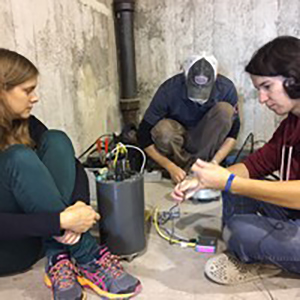

FanQuakes: Miami and OSU geologists collaborate to measure fan celebrations at Ohio stadium on a seismic scale
Sports fan and Miami University seismologist Mike Brudzinski is part of a team that is measuring fan-made seismic activity during football games at Ohio Stadium, the third largest football stadium in the United States.
The FanQuakes project is a collaborative effort among Ohio State University, Miami University and the Ohio Geological Survey to measure how much Ohio State fans are "Shaking The Shoe."
As fans jump up and down, the vibrations under the stands are measured by seismometers, the instruments used to measure the power of earthquakes.
The strongest FanQuake vibration registered this season was 5.79, after OSU's game-winning touchdown against rival Michigan in the double overtime game Nov. 26. The scale at the top of the screen on the video above (courtesy of Brudzinski) shows the shaking generated by fans jumping up and down.
The measurements will be featured in classes at Ohio State so that undergraduates can engage with real-world data and connect it to an experience many of them have had in person.
“At a more advanced level, we’ll use the data to teach data reduction and collection as well as wave propagation, earthquakes and the local geology," said project leader Derek Sawyer, assistant professor of earth sciences at Ohio State.
Several Miami students have already been involved in the data collection, including Miami doctoral student Shannon Fasola, who directs the field deployment of seismic instruments to study earthquake induced by oil and gas activities in eastern Ohio.
"Scientists like sports, too," said Brudzinski, professor of geology and environmental earth sciences. "It's amazing how much you can learn about how the world works when you're having fun. We were inspired by the dedication of players, coaches and fans that all contribute to making exciting plays and corresponding FanQuakes."

Maria Kozlowska (left), geology researcher, and Sarah Smith (right), geology master's student, work with Jeffrey Fox of the ODNR to install seismographic equipment in Ohio Stadium (photo courtesy of Shannon Fasola).
Project member Jeffrey Fox, a seismologist at the Ohio Department of Natural Resources, said that FanQuakes present a good opportunity to get people thinking about earthquake hazards in general.
How are FanQuakes recorded?
The FanQuakes project was inspired by the Pacific Northwest Seismic Network that recorded the infamous BeastQuake during a Seattle Seahawks playoff game in 2011, said the project team. Building on that effort, the team installed seismometers in Ohio Stadium this fall to record how much the stadium shakes during football games.
What generates the biggest FanQuakes?
There are two key ingredients, Brudzinski said:
-
Exciting football plays
Long duration plays generate a lot of fan excitement - think of fans jumping up and down while cheering "Go! Go! Go!," Brudzinski said.
-
Music you can jump to
Once we placed an instrument at the top of the student section, we found that the Ohio State students generate the largest FanQuakes, Brudzinski said. "Our recordings suggest that fun songs after exciting plays generated the biggest FanQuakes we've ever recorded."
How is a FanQuake Magnitude calculated?
The project team created the FanQuakes Magnitude Scale to help people understand how big different FanQuakes are. They used the seismometer readings from the fan shaking and compared them to how much regular natural earthquakes would shake the stadium.

Mike Brudzinski tweeted the highest FanQuakes seismic activity recorded during the OSU vs. Michigan game.
The Ohio Geological Survey is responsible for measuring natural earthquakes all across Ohio, so the team follows its approach. They measure the shaking with a seismometer and then find the equivalent magnitude of a natural earthquake if it occurred 10 kilometers (about 6.2 miles) below the stadium. Earthquakes that close to the stadium would produce shaking that lasts for about a second or less, so the longer shaking from fans that lasts many seconds is treated as a swarm of earthquakes beneath the stadium. The magnitudes are summed up every second, so the number grows during a fan-shaking event, Brudzinski said.
Visit the FanQuakes website for more videos, photos and other information.
Follow Brudzinski's Twitter storm from the OSU vs. Michigan game at twitter.com/seismohio.
FanQuakes Project team: Mike Brudzinski; Derek Sawyer, Ann Cook and Wendy Panero, OSU professors of earth science; Shannon Fasola, Miami geology doctoral student; and Ohio Geological Survey seismologist Jeff Fox and geologist Daniel Blake.
